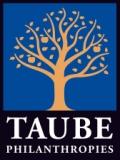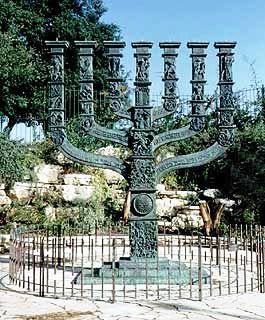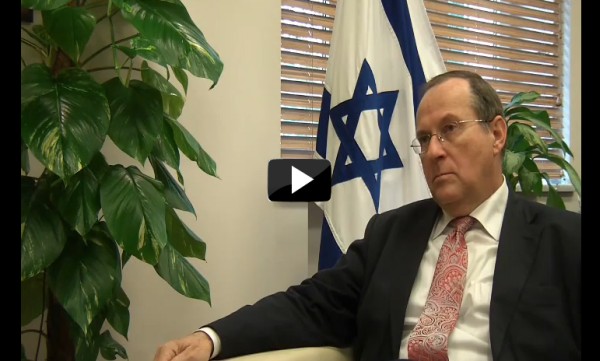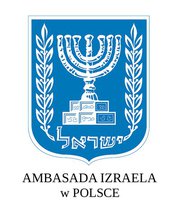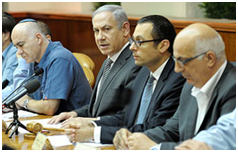|
 |
 |
|
IsraelHISTORY - CREATION OF THE STATE OF ISRAEL • 1950s and 1960s, • THE SIX-DAY WAR • ISRAEL - NATIONAL SYMBOLS • THE DECLARATION OF ESTABLISHMENT OF THE STATE OF ISRAEL • GOVERNMENT IN ISRAEL • ISRAEL: ZIONIZM • A COMMENT BY ISRAELI AMBASSADOR ZVI RAV-NER • GOLDSTONE UNDERMINES ITS OWN GAZA • REPORT PALESTINE IN UN - ISRAEL'S POSITION • GILAD SHALIT RETURNS HOME AFTER 5 YEARS OF CAPTIVITY
The creation of the State of Israel
Israel proclaimed its independence on 14th May 1948. 24 hours later the army of Egypt, Jordan, Syria, Lebanon, and Iraq invaded the State of Israel, forcing the government to defend the country. The 1948 Arab-Israeli War lasted for 15 months and, due to poor equipment and preparation, took life of more than 6 thousand Israeli soldiers, which was almost 1% of the total contemporary population of the State of Israel.
January 1949 was a turning point. Negotiations conducted under the auspices of UN between the representatives of the State of Israel and the neighbouring Arab states (only Iraq decided not to negotiate with the Israeli side) led to Armistice Agreements, according to which Galilee and Negev desert were included in the State of Israel, the East Bank of the River Jordan (i.e. Judea and Samaria) was under the jurisdiction of Jordan, the Gaza Strip was under Egypt control, Jerusalem was divided into two parts: the western part controlled by Israel and the eastern controlled by Jordan. 1949 Armistice Agreements allowed the State of Israel to focus on the development of the country, the creation of which took many lives. On 25th January 1949 there were first elections to the legislative branch of the government (with a 85% turnout), to which 120 representatives of the State of Israel were chosen. Those representatives constituted the Knesset whose first task was to choose the President who then had to appoint the Prime Minister (in years 1996-2001 the Prime Minister was chosen in a general election). Two statesman whose actions led to the creation of Medīnat Yisrā'el were elected. Chaim Azriel Weizmann was chosen to assume the role of the President (for many years he was the President of the Zionist Organization) and David Ben-Gurion was appointed to be the Prime Minister (he was a head of the Jewish Agency). On 11th May 1949 the State of Israel was included to the UN as a 59th member state.
According to the Law of Return the Jews were given the right to return and settle in Israel and to gain citizenship. During the first four months of the Aliyah more than 50 000 Jews entered the borders of the State of Israel (most of them were the Holocaust survivors). The Israeli population doubled in size up to 1951 due to massive wave of immigrants estimated at 687 000, out of which more than 300 000 were immigrants from the Arab states. The constant growth of population caused by subsequent Aliyahs and the 1948 War of Independence resulted in a difficult economic situation, so expenditure cutbacks and external financial aid were necessary to control the situation. Israel could afford to pay for construction industry development, agriculture mechanization, trade fleet and airlines creation, mining industry improvement, road and motorway building and power lines development thanks to loans from the USA and immense German war reparations. The industrial productivity and the number of people working in the industrial sector doubled, compared with the end of the first decade. It is also worth noticing that the export increased fourfold in comparison with the initial situation. Israel became self-sufficient in terms of basic agriculture produce (excluding meat and grains) thanks to vast areas allotted for agricultural purposes. 20 000 hectares of wasteland were converted into forest, so a green belt appeared along 800 kilometres of motorway.
The Israeli education system was also on a high level, developed earlier by the Jewish community during the statehood formation process. All Israeli citizens between 5th and 14th year of age were obliged to start and continue their education (since 1979 education was obligatory for young people who were 16 years of age. However, the education remained free of charge to the 18th year of age in the case when a young person continued his or her education.) Cultural and artistic life flourished thanks to the fact that different cultures and civilizations mixed together, i.e. cultural elements of the Middle East blended with those from South Africa and the West. The population of the State of Israel reached 2 million in the 10th anniversary of the state creation.
However, serious national security problems cast a shadow over years of statehood formation process. 1949 Armistice Agreements did not result in a durable peace as they were repeatedly violated. On 1st September 1951 Israeli vessels were not let into the Straits of Tiran waters in spite of UN Security Council resolution. In addition, Arab soldiers made numerous armed forays into Israeli territories and the Sinai Peninsula was surrounded by Egyptian military bases.
The Israeli people lived under constant threat until 1956 when a trilateral agreement was signed between Egypt, Syria and Jordan. However, the Israel Defense Forces (IDF) seized the Gaza Strip, the Sinai Peninsula and the west part of the Suez Canal during the Suez Crisis also referred to as the Tripartite Aggression or Suez War. UN decided to send United Nations Emergency Force (UNEF) to the border between two countries and to allow Egypt to use freely the Gulf of Aqaba which in turn forced Israel to retreat from the Sinai Peninsula. (Israeli forces had to leave this area between November 1956 and March 1957). The Straits of Tiran were reopened, so it allowed people to trade with Asia and East Africa and to import crude oil from countries with a coastline on the Persian Gulf.
The State of Israel improved the export and increased its GDP by 10% during the second decade of its existence (1958-1968). Formerly imported products, such as paper, tyres, radios and refrigerators, were manufactured in the country. The highest output increase was especially visible in mechanical, chemical and electronic industries. The agricultural sector, having satiated domestic needs, began an export of its produce to different countries. Thanks to a rapid industry development new ways of exportation became more than necessary. In order to support the growing needs, a new port was created in Ashdod (not far from the existing port in Haifa).
The Knesset Building was raised in Jerusalem, which positively influenced the Hebrew University and the Hadassah Medical Centre, situated on the opposite sides of Mount Scopus (Hebrew Har HaTsofim) . It was the same time when the Israel Museum was build. Its mission is to promote, to study and to teach about Jewish culture and history.
Israel developed also in terms of its international importance. The State of Israel cooperated more closely with the USA, the British Commonwealth of Nations, most of countries from Western Europe, almost all countries from Latin America and Africa, and some countries from Asia. The mutual exchange of experiences and achievements in subjects of physics, engineering, methodology of teaching, agriculture and irrigation sciences was possible thanks to the above-mentioned cooperation with the well-developed countries. 1965 was important because of an establishment of diplomatic relations with Germany, what seemed to be almost impossible due to the memory of Nazi and Holocaust experience which occurred in years 1933-1945. However, the relations between Germany and Israel normalized thanks to public discussion on the matter.
Unfortunately, the hopes for stability were foiled because of the threat imposed by Egypt and Jordan and compounded by a systematic destruction of moshavim in north Galilee. Israel was surrounded by the Arab states as Egypt deployed its forces on the Sinai desert, driving United Nations Peacekeeping forces from there and closing the Straits of Tiran in 1967. In addition, Jordan entered a military alliance with Egypt.
As Egypt violated all the agreements signed after the Suez Crisis in 1956, the State of Israel was forced to defend its independence and on 5th June 1967 it launched a simultaneous attack on all the three countries: hit Egypt from south, counter-attacked Jordan from east and destroyed Syria's forces on the Golan Heights.
As a result of the Six-Day War actions Israel seized the Gaza Strip, the Sinai Peninsula, the West Bank of the Jordan River (including East Jerusalem), and the Golan Heights. Northern cities were liberated from an almost 19-year-long Syrian control, the Straits of Tiran were reopened and all vessels could safely use these waters. Jerusalem, a divided city, was united under the Israeli control.
The emblem of the State of Israel
Menorah, a seven-branched ancient lampstand, surrounded by an olive branch on each side is a national emblem, symbolizing the yearning for peace expressed by Jewish nation. I recommend a short article about national symbols of the State of Israel.
Menorah
Menorah, a seven-branched lampstand, is a symbol of the State of Israel. The shape of menorah bears a certain resemblance to that of the plant Salvia palaestina. The photo shows the famous Menorah standing in the centre of Jerusalem, the capital city of Israel.
National flag
The flag is based on the design of the Tallit, the Jewish prayer shawl, which is white with blue stripes with a blue Star of David (Magen David, "shield of David").
THE DECLARATION OF ESTABLISHMENT OF THE STATE OF ISRAEL
Erec Jisrael (the Land of Israel) was the cradle of Jewish nation. Here its spiritual, religious and political identity was shaped. This was the place where Jews created the statehood for the first time, where national and universal culture values were created and where the immortal Book of Books appeared.
(...) Each subsequent Jewish generation tried to settle in their ancient homeland. (...) They managed to make deserts blossom, they revived Hebrew language, they built settlements and towns. They created strong society which controlled the national economy and developed their culture. They loved peace but they also knew how to defend their country (...).
The State of Israel is going to be open to Jewish immigrants (...), it is going to sustain the national development for people's good. Israel is going to respect the liberty, justice and peace, in accordance with the vision made by old Israeli prophets. The State of Israel is going to ensure equal rights in terms of society and economy, regardless of religion, race or sex. The freedom of religion, beliefs, language, education and culture is going to be ensured. Israel is going to guard the sacred places of all religions and remain faithful to the principles of the Charter of the United Nations.
We extend a hand to all the neighbouring countries and their citizens, offering peace and good relations and we ask for a cooperation with and mutual aid for an independent Jewish nation settled in their own country.
Hatikvah - The Hope
The anthem was written by Naphtali Herz Imber, a secular Galician Jew from Zolochiv (contemporary Lviv Oblast in Ukraine). He moved to Israel in the early 1880s, where he created the anthem revolving around the nearly 2000-year-old hope of the Jewish nation to be free and sovereign people in the Land of Israel. This dream came true when the State of Israel was established in 1948, and commonly known Hatikvah was unofficially proclaimed the national anthem. [However, it did not officially become the national anthem until November 2004. - added by the translator]
Hatikvah- The Hope is the national anthem of Israel. HATIKWA KOL OD BALEWAW PNIMA NEFESZ JEHUDI HOMIJA ULFATEJ MIZRACH KADIMA AJIN LECIJON COFIJA OD LO AWDA TIKWATEJNU HATIKWA BAT SZNOT ALPAJIM LIHIOT AM CHOFSZI BEARCEJNU EREC CIJON WIRUSZALAJIM
As long as in the heart, within, A Jewish soul still yearns, And onward, towards the ends of the east, An eye still gazes toward Zion; Our hope is not yet lost, The hope of two thousand years, To be a free people in our land, The land of Zion and Jerusalem.
http://www.tkdami.pl/~martin/israel/hatikva.mid
The government (a ministerial team) is an executive power authorized to deal with domestic and foreign affairs, including the issues of national security. The range of government responsibilities is wide, as it is authorized to take actions in all affairs which are not the subjects to other authorities. The way of its functioning is determined by the government. The cabinet meets usually once a week; if necessary, additional meetings may be organised. The government may work by means of ministerial committees. All previous governments were formed by a coalition of different parties as none of them was able to collect the minimum number of seats in Knesset in order to create an independent cabinet.
The President selects one of the members of Knesset and entrusts him/her with the task of creating a new government. The selected member has to prepare and submit to Knesset the list of ministers and a government activities draft. As soon as the list and draft are approved, the ministers selected are directly responsible to the Prime Minister for their duties and to the Knesset for their actions. Most of the ministers are given a ministerial portfolio and an official title. Ministers without portfolio may be responsible for particular projects. The Prime Minister may function as a minister with a special authorization. All ministers must have Israeli citizenship and permanent residency in Israel. Ministers, with a consent given by the Prime Minister and government, may appoint a deputy chosen from the Knesset.
The government holds its office for four years (it is similar to Knesset); however, it may be shortened in the case of Prime Minister's resignation or death, or in the case of the vote of no confidence accepted by Knesset. If the Prime Minister dies or is unable to fulfil his/her responsibilities due to resignation or impeachment, the government will appoint one members of Knesset to be a Prime Minister. In the case of the vote of no confidence the government and the Prime Minister hold their position until a new government is created.
Theodor Herzl
"You want to found a state without bloodshed? Where did you ever see that? Without violence and without guile, simply by selling and buying shares?" asked the sociologist Ludwig von Gumplowicz in a letter to Herzl just few years after the First Zionist Congress. On 29 August 1897 two hundred men who believed in the reconstruction of Jewish nation in the Promised Land gathered in the casino in Swiss Basel. They believed in the concept published by Jewish journalist Theodor Herzl in a small book entitled "Der Judenstaat".
The Zionist century 1897-1997
Zionism is a Jewish national movement that has supported the self-determination of the Jewish people in a sovereign Jewish national homeland and has promoted the return of Jews to the Land of Israel. The longing for Zion and Jewish migrations lasted throughout the exile, since the Roman conquest and the destruction of the Second Temple in 70 CE. This longing transformed into a new form in XIX century when contemporary nationalism, liberalism and emancipation forced Jews to pose some questions, for which Zionist movement tried to find the answers. Hovevei Zion, also known as Hibbat Zion, began to unite in the second half of the XIX century but the most important changes came after 1987, right after Theodor Herzl called the First Zionist Congress. It was how a political movement began. Feel invited to read more about Zionism.
Zionist ethos
"In the Israeli-Hebrew prose, which began in 1948, there are three main generations. These generations should be considered in terms of literature rather than biology. It is worth mentioning that all important representatives of these generations still live and write, and their texts change, influenced by the contemporary global and Israeli literature and by younger writers." You can read more about it... (Zionist ethos in Israeli prose from 1948 to 1990s.)
A COMMENT BY ISRAELI AMBASSADOR ZVI RAV-NER
Ladies and Gentleman, click the link below to watch a short comment made by Israeli ambassador Zvi Rav-Ner on the subject of the last incidents next to Gaza Strip, i.e. a brutal attack on Israeli soldiers during an attempt to intercept one of the vessels of the flotilla. http://www.youtube.com/watch?v=N6NaYt3oeKA
4th April 2011 GOLDSTONE UNDERMINES ITS OWN GAZA REPORT On 1st April 2011, Richard Goldstone published in The Washington Post an article in which he undermined the accusation of Israel on the subject of its actions in the Gaza War, known as Operation Cast Lead, which were aimed at Hamas in December 2008 and January 2009.
Richard Goldstone headed a UN special mission to investigate the military actions taken by the Israeli soldiers. In the article Goldstone criticized his own report saying "If I had known then what I know now, the Goldstone Report would have been a different document".
Goldstone admitted that the Israeli forces did not deliberately attack the civilian population of the Gaza Strip. Independent Israeli institutions conducted internal investigations on the matter of improper use of resources by the Israeli army.
The article emphasized the fact that Hamas did not investigate the case of rocket attacks targeted at Israeli civilians, which should bring an accusation of war crimes committed by Palestinian militants. The article also underlined the negative attitude of United Nations Human Rights Council towards Israel. Goldstone confirmed also the alleged United Nations bias in Israel-Palestine issues. The Goldstone's article was also discussed by the Polish media. Unabridged article written by Richard Goldstone can be found here The Washington Post.
PALESTINE IN UN - ISRAEL'S POSITION
GILAD SHALIT RETURNS HOME AFTER 5 YEARS OF CAPTIVITY
The Israeli soldier Gilad Shalit will return home after being held by the Hamas militants for over five years. The Israeli government accepted an agreement suggestion on the strength of which Gilad Shalit will return home safe and sound.
The Prime Minister Netanyahu indicated that release negotiations were resumed a few weeks ago in Cairo, with an Egyptian government as a mediator. Israeli negotiators had to take into consideration the security issues, which could result from an agreement reached with Hamas, i.e. a terrorist organization.
The Prime Minister Netanyahu admitted that the decision to reach an agreement with Hamas was very difficult: "As we stood yesterday at the court with the bereaved families, we sympathise with them, we understand their pain. This is a difficult decision to make, but a leadership is examined in moments like these, in its ability to make difficult decisions."
During today's meeting with Gilad Shalit's father, Noam, The Prime Minister Netanyahu assured him that his son will return home within few days.
English version of this website was prepared by students from the Student Translation Bureau at the University of Bialystok. Visit thier website: www.sbt.uwb.edu.pl
|
|
|||||||||||||||||||||||||||||||||||||||||||||
|




